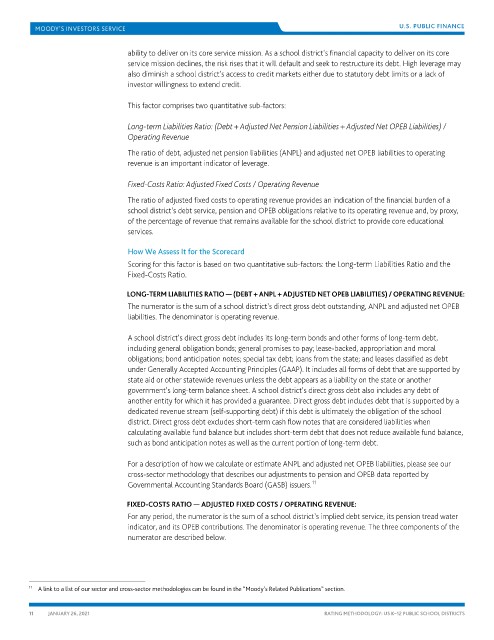Page 1645 - draft
P. 1645
U.S. PUBLIC FINANCE
ability to deliver on its core service mission. As a school district’s financial capacity to deliver on its core
service mission declines, the risk rises that it will default and seek to restructure its debt. High leverage may
also diminish a school district’s access to credit markets either due to statutory debt limits or a lack of
investor willingness to extend credit.
This factor comprises two quantitative sub-factors:
Long-term Liabilities Ratio: (Debt + Adjusted Net Pension Liabilities + Adjusted Net OPEB Liabilities) /
Operating Revenue
The ratio of debt, adjusted net pension liabilities (ANPL) and adjusted net OPEB liabilities to operating
revenue is an important indicator of leverage.
Fixed-Costs Ratio: Adjusted Fixed Costs / Operating Revenue
The ratio of adjusted fixed costs to operating revenue provides an indication of the financial burden of a
school district’s debt service, pension and OPEB obligations relative to its operating revenue and, by proxy,
of the percentage of revenue that remains available for the school district to provide core educational
services.
How We Assess It for the Scorecard
Scoring for this factor is based on two quantitative sub-factors: the Long-term Liabilities Ratio and the
Fixed-Costs Ratio.
LONG-TERM LIABILITIES RATIO — (DEBT + ANPL + ADJUSTED NET OPEB LIABILITIES) / OPERATING REVENUE:
The numerator is the sum of a school district’s direct gross debt outstanding, ANPL and adjusted net OPEB
liabilities. The denominator is operating revenue.
A school district’s direct gross debt includes its long-term bonds and other forms of long-term debt,
including general obligation bonds; general promises to pay; lease-backed, appropriation and moral
obligations; bond anticipation notes; special tax debt; loans from the state; and leases classified as debt
under Generally Accepted Accounting Principles (GAAP). It includes all forms of debt that are supported by
state aid or other statewide revenues unless the debt appears as a liability on the state or another
government’s long-term balance sheet. A school district’s direct gross debt also includes any debt of
another entity for which it has provided a guarantee. Direct gross debt includes debt that is supported by a
dedicated revenue stream (self-supporting debt) if this debt is ultimately the obligation of the school
district. Direct gross debt excludes short-term cash flow notes that are considered liabilities when
calculating available fund balance but includes short-term debt that does not reduce available fund balance,
such as bond anticipation notes as well as the current portion of long-term debt.
For a description of how we calculate or estimate ANPL and adjusted net OPEB liabilities, please see our
cross-sector methodology that describes our adjustments to pension and OPEB data reported by
11
Governmental Accounting Standards Board (GASB) issuers.
FIXED-COSTS RATIO — ADJUSTED FIXED COSTS / OPERATING REVENUE:
For any period, the numerator is the sum of a school district’s implied debt service, its pension tread water
indicator, and its OPEB contributions. The denominator is operating revenue. The three components of the
numerator are described below.
11 A link to a list of our sector and cross-sector methodologies can be found in the “Moody’s Related Publications” section.
11 JANUARY 26, 2021 RATING METHODOLOGY: US K–12 PUBLIC SCHOOL DISTRICTS

